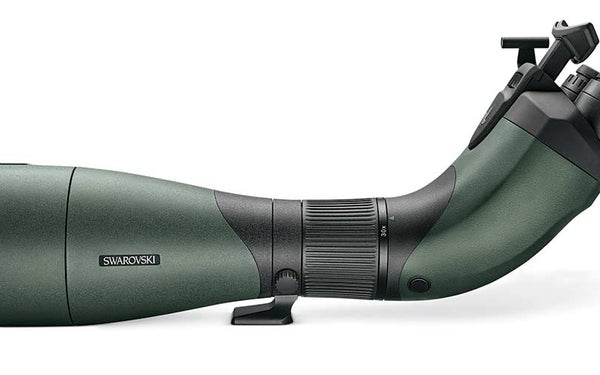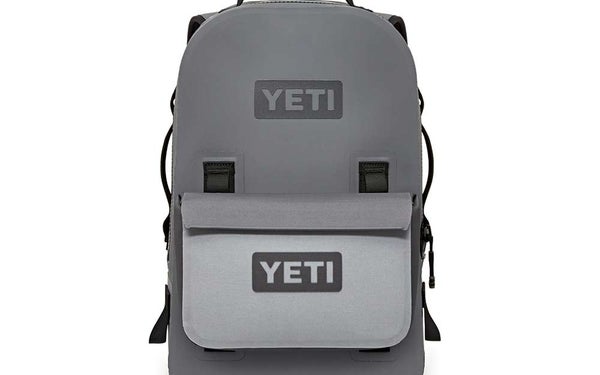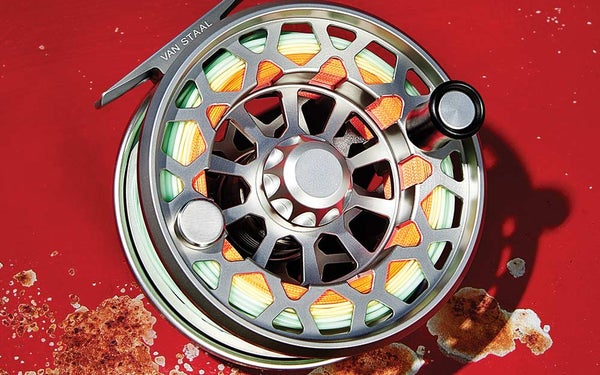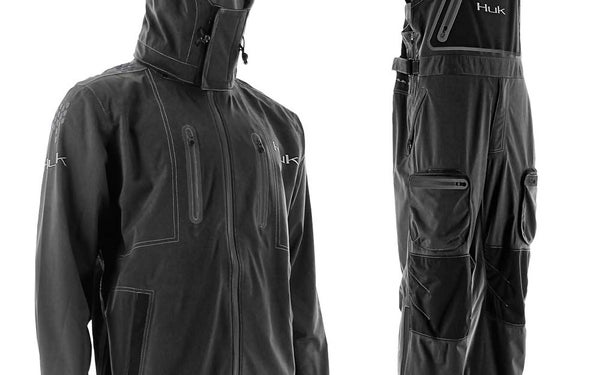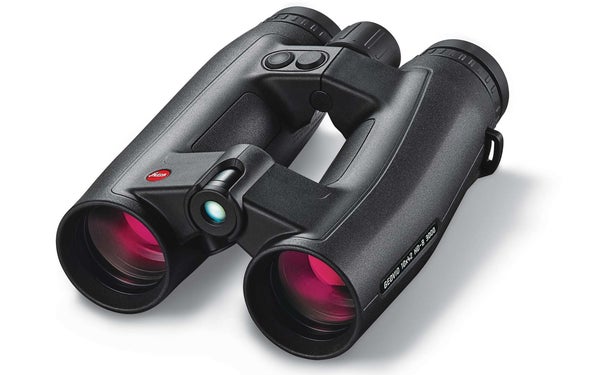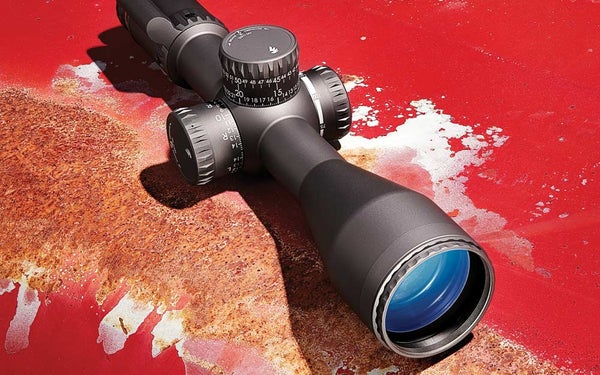The Best Hunting and Fishing Gear of 2018
We pick the top outdoor gear of the year in our annual Best of the Best Awards.

We may earn revenue from the products available on this page and participate in affiliate programs. Learn more ›
No one was surprised that an optic with the Swarovski name took top honors for spotting scopes in our annual optics test. But our testers didn’t expect this one, with its binocular eyepiece, to dominate the field the way it did. Swarovski’s flagship spotter is built on a modular system that allows easy swapping of objective and ocular elements. This BTX configuration, with the dual eyepiece and 95mm objective, is new for 2018.
With the eyepiece in place, the spotter becomes a fixed 35X optic, and because of that we assumed it wouldn’t score as well as traditional spotters with generous zoom ratios. What we found, however, is that the extra visual data that comes from the dual eyepiece allowed us to resolve images better than did any of the single-eyepiece spotters we tested. We observed this while watching game on distant hills through heavy mirage at midday, while looking at stars and other objects in the night sky, and while running this spotter side by side against the rest of the field in crisp, clear conditions.
The other factor that tipped our evaluation in the BTX’s favor was viewer comfort. Minimizing eye fatigue is the name of the game for long glassing sessions, and we’ve never used a spotter as easy on the eyes as this one. Plus, the BTX eyepiece features a forehead rest that you can set for perfect eye relief.
I recently took the BTX on a two-week self-guided moose hunt in Alaska, where it withstood the rigors of nonstop rain and rough use, proving that the system, with its latest components, is a full-fledged hunting optic that you can take anywhere. —John B. Snow

Yamaha Wolverine X2
sThe perfect hunting rig needs to be roomy enough to carry a couple of hunters and all their gear, powerful enough to get them into hard-to-reach places, and quiet enough to not send deer bolting in every direction. The new Yamaha Wolverine X2 does all that, with a killer warranty and a surprising extra that’s perfect for the outdoorsman. It starts with a brand-new 847cc twin-cylinder engine that is both very quiet and torquey. The high-back, bolstered seating, generous leg room, and finely tuned suspension make the X2 a joy to ride. Other great features include electric power steering, On-Command 4WD, Yamaha’s Ultramatic CVT transmission, and an incredible industry-first 10-year CVT belt warranty. And here’s the kicker: The X2 comes pre-wired for Yamaha’s exclusive Adventure Pro GPS system for mapping those secret spots on the hunt property. Of course, it also comes in camo. —Rick Sosebee
Yeti Panga Backpack 28 and SideKick Dry • $300 for Panga; $50 for SideKick YETI
I’ve developed trust issues with so-called “watertight” backpacks, so before I even got my hands on Yeti’s new Panga 28, I was skeptical. I loaded it up with my snakehead tackle and took it on every outing from July through October. It faced soaking conditions, thanks to an incredibly rainy summer in the Northeast and the marshy, muddy places where snakeheads live. Nothing inside ever got a drop of water on it. Of course, the Panga is going to cost you. It is from Yeti. But it’s worth the price for the peace of mind: This pack is built to last and will save your stuff if you accidently take a dip while wading. Yeti’s SideKick Dry (sold separately) is a nice add-on that clips neatly to the front of the Panga, and is perfect for quick access to items like your phone, wallet, and keys. —Joe Cermele

Federal Heavyweight TSS
I’ll always remember the spring of 2018 as the year that my buddies—who will a suffer throat infection before spending $5 on a new mouth call—declared that they would gladly pay $10 a shell for a box of turkey loads.
That’s how good TSS is.
With their help, I spent days with a patterning board, testing this stuff through several different 12-gauge guns. With the right choke, the patterns were absolutely devastating. But my most impressive range test was with the .410 loading out of a Remington 870 with a fixed Full choke. With 13⁄16 ounce of No. 9 TSS, that combo outperformed my 20-gauge with 11⁄4-ounce lead turkey loads, a .575 turkey tube, and fiber-optic sights—a setup that I’ve personally seen kill gobblers at 40 steps.
So, how does TSS work on turkeys? I watched the 12-gauge loads tumble half a dozen birds, including a couple of my own, at ranges from 10 to 40 yards. I’ve heard claims of longer clean kills with TSS, but I didn’t see any of those myself. When I’m doing the calling, I don’t allow nonsense like that. But I can say with confidence that if you have even the slightest doubt about No. 9 TSS pellets’ lethality on a tom, don’t. —Will Brantley
Van Staal reels are for anglers who don’t mess around. The company’s spinning reels are practically unbreakable, capable of beating anything from a 200-pound bluefin in New England to a trophy giant trevally halfway across the world. The same was true of the company’s original fly reels. Unfortunately, it discontinued them many years ago, making them prize possessions for anglers who were smart enough to snap them up. For those who weren’t, take heart: Van Staal has re-entered the fly scene with its new VF series, and they’ll be easier on your wallet than the originals.
Available in models ranging from 3- to 12-weight, the VF series was engineered to be extremely lightweight while maintaining the strength to battle bruiser fish. It’s the unique pentagonal pattern in the frame and spool that allowed Van Staal to reduce metal—and weight—while maintaining high structural integrity. Add in a sealed drag supported by three bearings, and there’s not a steelhead or sailfish in the world you can’t slow down.
I’ve been using a 10-weight all summer and fall for everything from mahimahi to false albacore to pike. Not only has it rolled over every fish like a tank, but I can bang it off a rock or the boat rail without worrying about anything getting out of whack. —J.C.

Seekins Precision Havak Pro Hunter
This new rifle from gunmaker Glen Seekins makes a bold visual impression. The deep spirals machined into the barrel and bolt body give the Havak Pro Hunter a hotrod flair. Combine this with the racy lines of the stock, and you have a rifle that talks a big game.
Turns out, it performs as well as it looks. The Havak comes with a threaded muzzle for attaching a muzzle brake or suppressor, but even without either, the rifle is easy to control and accurate. Chambered in Hornady’s new 6.5 PRC (see next page), my test gun averaged .75-inch 5-shot groups and delivered some .5-inchers with current 6.5 PRC factory offerings.
Seekins is a proven competitive shooter as well as a serious Western big-game hunter, and the Havak is a smart blend of both those passions. The stock geometry—with its nearly vertical pistol grip, substantial palm swells on both sides of the grip, beefy fore-end, raised comb, and flush-mounted QD sling attachments—takes its cues from the world of tactical field matches. But unlike competition rifles, which can weigh up to 20 pounds, the Havak tips the scales at a very portable 7 pounds 3 ounces, thanks to those spiral cuts in the barrel and bolt and the carbon fiber used in the stock and for the detachable box magazine. For the price, you won’t find a better-performing rifle out there. —J.B.S.
Sig Sauer Sierra3 BDX 4.5-14x50mm
I’ve been told that the key to a successful marriage is communication. Never having had one of those, I can’t say for sure—but I do know that communication is the key to this intriguing new system from Sig Sauer.
With Bluetooth technology, the Sierra3 BDX scope works with Sig’s BDX-enabled Kilo rangefinders to give the shooter an aiming point by illuminating small OLED dots along the vertical stadia of the duplex reticle. The system also gives wind-hold indications along both sides of the horizontal crosshair—the shooter just needs to use the one for holding into the wind.
This alone makes the BDX (for ballistic data exchange) an interesting system, but Sig has augmented it with a couple of other slick features. The scope is a second-focal-plane optic, which typically means that the holdover reticle needs to be used at a specific magnification level, usually max power. This is a significant drawback—but one that the BDX system eliminates. Because its aiming points move as the scope’s power is changed, you can use whichever magnification level the situation calls for. The entire system is predicated on inputting data about the rifle and ammunition being used, including bullet weight and velocity. So, along with all the other features, it can calculate the kinetic energy of the projectile at the target distance. If that number drops below a threshold chosen by the shooter, the aiming point will blink, providing a good check on taking a potentially unethical shot.
Our test model, a 4.5–14×50, goes for $1,080 with the Kilo rangefinder. But the system can be had for $840 if you get the base-model scope—a very reasonable cost for this degree of innovation and utility. —J.B.S.
Hornady 6.5 PRC
The newest 6.5 offering is a short-mag based on the 300 Ruger Compact Magnum. Using ballistically efficient 6.5 bullets of 140 grains or more, it is a flat-shooting and hard-hitting cartridge that is suitable for everything short of thick-skinned dangerous game. Hornady is currently offering it with two factory loads: the 147-grain ELD Match and the 143-grain ELD-X hunting bullet. Muzzle velocities from a 24-inch barrel are at 2,910 fps and 2,960 fps, respectively. Those sub-3,000 fps speeds will help prolong barrel life.
I’ve shot several animals with the 6.5 PRC over the last year. For hunting the West, it is difficult to imagine a more well-rounded cartridge. The bullets performed perfectly, with good penetration and expansion at 400 yards and beyond. —J.B.S.
Huk Next Level Kryptek All Weather Jacket and Bib • $350 for jacket; $350 for bib HUK Gear
Huk’s 100 percent waterproof, 100 percent windproof rain gear completely seals you off from the elements without cooking you in your own juices. Which means that even in the hottest, muggiest weather, you stay bone-dry and comfortable. Hinged Velcro cuff closures, waterproof zippers, and a removable hood add to the watertight package to protect you on long, rough runs or while fishing in an absolute downpour. Plus, there’s a convenience zipper for when nature calls.
Despite the armorlike qualities, the jacket and bib are surprisingly lightweight and comfortable. I wore them for hours in the worst conditions this summer and fall without missing a beat. And when the day is done, this stuff stows better than any other high-end foul-weather gear I’ve tried. Available in Kryptek Raid or black (shown). —Mark Modoski
This latest Geovid mates Leica’s vivid image quality with an upgraded rangefinder that is more powerful and precise than previous models. The stylish body geometry gives this 10×42 excellent in-hand balance. When you bring the optic up, your eyes seem to fall right into the view. The controls on the Geovid are silky and precise as well, making extended glassing sessions a joy.
The rangefinder works out to 3,000 yards under ideal circumstances, and well beyond a mile (1,760 yards) even in less-than-ideal conditions, such as light precipitation. Ballistic data can be loaded into the unit to give the user a shooting solution in the viewfinder as well. Air temperature and pressure sensors and an angle indicator on the unit help with those calculations. Yes, it carries a hefty European-optic price tag, but this 10×42 is among the best big-game hunting binos that you can hang around your neck. —J.B.S.

Shimano Curado Casting Rod
Anglers know the name Curado. For years, it has referred specifically to Shimano’s line of workhorse baitcasting reels and has come to denote high quality at a manageable price. So, when the company developed a line of rods with the same qualities, it only made sense to put the Curado name on them. It’s a high standard to live up to, but these new sticks don’t disappoint.
The blanks on the Curado series are a blend of traditional carbon and Nanoresin—a high-modulus mix that increases responsiveness and power, resulting in lightweight, sensitive rods that store and release more energy for longer and more accurate casts, and that still pack plenty of backbone to muscle big gamefish to the boat. Every model in the line features high-end Fuji products from tip to butt, including tangle-free guides and a rubberized soft-touch reel seat. The cork grip is comfortable and ergonomic—perfect for all-day casting. The Curado line of casting rods has 23 different models that cover a wide range of fishing techniques, from a 6-foot-10-inch medium/fast rod for smaller presentations to a beastly 8-foot extra-heavy/fast model for throwing huge baits and muscling lunker fish. —M.M.
13 Fishing Concept Z Casting Reel
The Concept Z is not the first reel without traditional ball bearings, but it is the first to deliver best-in-class performance. The cornerstone of the reel is the Concept Zero Bearing (CZB), perfected by 13 Fishing after years of R&D. The CZB self-lubricates and never needs service, it doesn’t wear or rust, and its performance only improves with time and use. Translated into fishing terms, the Concept Z will throw the smallest lures significantly farther than other low-profile baitcasters.
Both the cast and the retrieve are incredibly smooth and quiet right out of the box. The Concept Z is also armed with 13 Fishing’s Bulldog drag system, which packs more than 22 pounds of stopping power. The reel’s performance and power are tucked neatly into a lightweight and rigid 6.4-ounce package that can be used in fresh water or salt. Soft, comfortable EVA handle grips, and a six-point centrifugal brake that can be changed on the fly add to the reel’s utility. The Z is available in three right-handed models with gear ratios of 6.6:1, 7.3:1, and 8.1:1, and one left-handed model with a gear ratio of 7.3:1. A beefed-up Concept Z for larger freshwater and inshore species is currently in the works. —M.M.
St. Croix Legend X Spinning Rod
St. Croix left us little choice but to give them a Best of the Best award for the Legend X, which the company stuffed with every one of its state-of-the-art technologies and finished with ultra-high-end components. For starters, the rods are built with 100 percent corrosion-resistant titanium Fuji tangle-free guides with Torzite rings, which are smoother and harder than all other guide ceramics. The blank features super-high-modulus SCVI graphite in its lower section, which increases power while reducing weight, and high-modulus/high-strain SCV graphite with a carbon-matte scrim on the upper section, which adds both durability and sensitivity. The Legend X is tooled with St. Croix’s Integrated Poly Curve (IPC) technology, which eliminates transition points along the length of the rod. The blank also incorporates St. Croix’s Advanced Reinforcing Technology (ART), which reduces deformation under load and maximizes power. A titanium Kigan hook keeper, Fuji TVS blank-touch reel seat, and super-grade cork round out this paragon of spinning rods, handcrafted in Park Falls, Wisconsin. There are five spinning models, ranging from a 6-foot-10-inch medium/light to a 7-foot medium/heavy. —M.M.
Shimano Exsence spinning reel
The Exsence has been called the “Batmobile” because of its sleek matte-black finish and modern curves. But looks alone don’t make this reel worth more than $500. What commands that price are the reel’s guts and engineering, which make it one of the smoothest, most dependable spinning reels I’ve ever fished. It’s been my A reel since April, coming along on everything from river smallmouth hunts to American shad quests and trophy chain pickerel missions. I know that if I took it out for more feisty players like stripers or steelhead, it would handle them too. The magnesium Hagane body is incredibly lightweight yet strong, while Shimano’s X-Protect technology provides a water-repellent coating on internal parts that’s not as thick as grease, allowing Shimano to use much lighter gears and rotors to reduce overall weight. There is more state-of-the-art technology in this reel than I can mention here, but it’s all aimed at creating a reel with tolerances that will never loosen up, making it feel fresh out of the box season after season. If you’re one of those anglers who prefers to be married to your gear rather than have to replace it every few years, the Exsence is worth the investment. —J.C.

Mathews Triax
Hunters want long axle-to-axle bows these days, right? Wait—that’s changed again, already? True enough, 33- to 35-inchers had their days of dominance in our annual test of flagship compound bows, and there are still some very good ones on the market. They’re just not as good as this trim little Triax, which is just 28 inches axle to axle and has earned Best of the Best honors this season. The Triax looks similar to the Halon, which won the same title in 2016, and to the Halon 32, which took second in last year’s test. But this latest model is, in my opinion, the best of the bunch. Mathews shaved away some of the weight and bulk of the previous Halons, which was a complaint from some testers. But that’s not all to like in this bow. It’s quieter than anything we’ve ever tested and almost totally free of vibration—and that’s not just because the pro staffer of the week told us so; we verified it in sound chambers during a grueling test with the staff of Stress Engineering.
Though short, the Triax is as easy to settle and hold on target as many longer bows. And set to IBO specs, it proved plenty fast on our chronograph, at 330 fps. It was also among the most accurate and forgiving bows in the 2018 lineup. It’s late September as I write this, and I’ve been hunting with this bow for a few weeks now. It’s the shortest bow I’ve ever taken afield, and it’s just unbelievably handy in a treestand or ground blind. The other day, I shot a doe through both lungs with it, and by golly, she fell over quick too. A week later, another doe made the mistake of peering up at my stand and stomping her hoof at 25 yards. At the shot, she ran about 40 yards and then tipped over. “Good juju” isn’t listed in the specs of any bow I’ve seen, but this one seems to have it. —W.B.
TenPoint Stealth NXT
There are three key things most people want in a new crossbow: speed, accuracy, and nimble handling. That’s why those categories are double-weighted in our annual test of flagship crossbows. But we evaluate trigger pull, fit and finish, cocking effort, safety, and value too. This year, after a couple of targets were shot out, many bolts were broken, and all the scores were tallied, TenPoint’s Stealth NXT was the walkaway Best of the Best winner in the crossbow category. It’s just 6 inches wide axle to axle when cocked and weighs 7.3 pounds without accessories. It handles nicely, and we clocked the supplied 449-grain bolts at 392 fps. The bow’s average 3-shot group at 30 yards from a rest measured 1.06 inches.
Year in and year out, TenPoint produces some of the best crossbows on the market, and the same goes for its accessories, from the scope and bolts to cocking devices and cases. With the Elite accessories package (one of several available), the Stealth NXT carries a final MSRP only a buck shy of $1,500. I sold my first pickup truck—a four-wheel-drive that was running like a top—for less money than that. But compared to the price of the other high-end crossbow competition, it’s a solid buy. —W.B.

Rizzini BR 110 Sporter
The Rizzini BR 110 Sporter was the hit of our annual shotgun test. “It just seems to find the bird,” said one tester, and that’s what happens when you shoot a well-balanced sporting gun. It helps, too, that the 110 Sporter boasts light, clean trigger pulls. Despite its affordable price, the Rizzini comes packed with competition features, including lengthened forcing cones, five extended choke tubes, vented side ribs, a hefty competition-style stock and fore-end, and a fiber-optic bead.
While there’s nothing flashy about the BR110 Sporter, it is good-looking in a low-key way. The metal parts are matte gray instead of gloss-blued, and our test gun had a nicely figured walnut stock. Rizzini shotguns have a track record for reliability that makes this a great choice for a shooter who is after a trouble-free entry-level clays gun. In 12 and 20, it’s available with your choice of 30- or 32-inch barrels. In 28 and .410, the tubes are 30 inches. In any configuration, it’s a lot of gun for the money. —Phil Bourjaily

The White River Small Game Knife
I don’t know how many knives have been chosen as Best of the Best simply because they didn’t get cute at the expense of usefulness, but it’s a lot. The Small Game Knife from White River Knife & Tool is a perfect example. Designed by custom smith Owen Baker Jr., this no-frills drop-point has a 2.62-inch-long fixed blade made of CPM S35VN, which is a dedicated knife steel, and can be ordered with any of six handle options, all synthetic. The handle, which is just over 41⁄2 inches long, gives you a decent grip and real leverage.
In the end, what you have here is an enlarged scalpel that’s useful all out of proportion to its size. It will gut a deer, breast a grouse, or slice carrots with equal agility, and it comes with a nice leather sheath. —David E. Petzal
This scope might cause purists to recoil in horror, but make no mistake—the Revic, with its integrated electronics and slick heads-up display system, is a glimpse at the future of sport and hunting optics. The 4.5X–28X magnification range is geared toward the precision rifle crowd, but you can expect to see Revic expand this lineup soon to include offerings with more modest, hunter-oriented magnifications.
The Revic works by gathering real-time environmental data via onboard sensors—air temperature, barometric pressure, humidity, etc.—and using it to perform calculations with pre-entered ballistic information on the cartridge used. That data is uploaded to the Revic via a relatively simple smartphone app that allows the shooter to manage multiple gun and cartridge profiles. Staring through the scope, the shooter sees a normal MOA-based holdover reticle with hashmarks, but at the top of the view—in the rafters, as one evaluator put it—the Revic displays a wealth of data. As the elevation dial is manipulated, the display shows the yardage at which the bullet will impact. So if your target is at 856 yards, you just spin the turret until that’s what the display reads. You can also quickly input windage information using the keypad to the left of the elevation turret, which will then show the wind correction in the display. There’s also an indicator to show if the crosshairs are level, which is critical for long-range accuracy. This scope definitely has a learning curve. There’s a lot of data a shooter needs to gather to set it up, but after you’ve done it once, the process goes quickly. The payoff is huge. Once you’ve fine-tuned your ballistics, the Revic becomes a one-shot wonder, placing first-round impacts on steel at long range. Using this system, I quickly got my 6.5×47 on target to 1,400 yards, and at under 1,000, it seemed like I couldn’t miss. The term “game changer” is bandied about too casually, but that is exactly what the Revic is. —J.B.S.

St. Croix Mojo Trout Fly Rods
St. Croix’s catalog is massive, loaded with specialty sticks for pretty much every species of fish that swims. The price range of the brand’s rods is massive too, offering anglers of any skill level and with any budget a high-quality rod. One might assume, then, that its new line of specialty Mojo Trout fly rods would cost a pretty penny, but they do not. More important, that low price doesn’t come at the cost of quality. Available in 11 models, the Mojo Trout line features solid components, including extra-hard Sea Guide snake guides that increase cast smoothness, durable aluminum-oxide stripping guides, and machined aluminum reel seats. When I checked out the 7-weight at ICAST 2018, I was amazed by how light and responsive it was, making me think it could pull double duty as a streamer rod and a dry-fly rod in a pinch. St. Croix made an effort to cater to small-stream anglers by offering 3- and 4-weight models in lengths ranging from 6-foot to 9-foot, with plenty of options in between. To be clear: This is not a “beginner” series of fly rods. I put the hurt on some big rainbow trout this fall with the 7-weight (which casts like butter), and I believe it’s found a permanent home in my travel tube of go-to sticks. —J.C.
